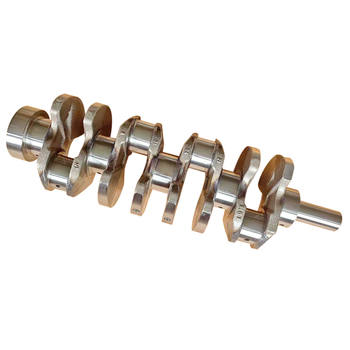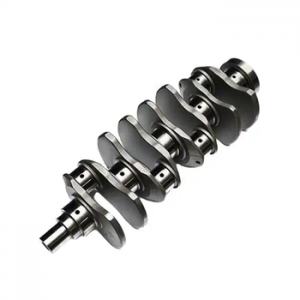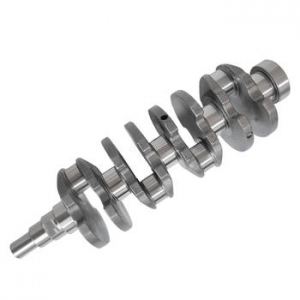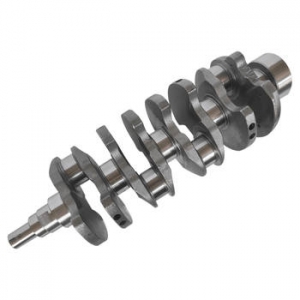The Ultimate Guide to Sourcing Bulk Engine Crankshafts for Your Business
At the very heart of every internal combustion engine lies a component of immense strength and precision: the crankshaft. It’s the backbone of the rotating assembly, converting the linear motion of the pistons into the rotational force that ultimately turns the wheels. For engine rebuilders, performance shops, and small-scale manufacturers, the crankshaft isn't just a part; it's a critical asset. And when your business relies on a steady stream of these assets, the conversation shifts from buying one-off parts to a much more strategic approach: sourcing bulk engine crankshafts.
Frankly speaking, moving into bulk purchasing can feel like a major leap. It involves more capital, more storage, and a deeper understanding of the supply chain. However, the rewards in efficiency, cost-savings, and quality consistency can fundamentally change your business's trajectory. Have you ever wondered how high-volume engine shops maintain their competitive edge and consistent build quality? A big part of the answer often lies in their procurement strategy. This guide will walk you through everything you need to know to confidently navigate the world of buying crankshafts in volume.
Why Consider Buying Bulk Engine Crankshafts? The Strategic Advantage
The decision to start purchasing any component in bulk isn't one to be taken lightly. It’s a strategic move that extends far beyond just getting a better price per unit. When it comes to a component as fundamental as a crankshaft, the benefits ripple throughout your entire operation.
Cost Savings and Economies of Scale
Let's start with the most obvious benefit: cost. It's simple economics. Manufacturers and distributors reward larger orders with lower per-unit pricing. They save on administrative overhead, packaging, and logistics for a single large order compared to dozens of smaller ones, and they pass a portion of those savings on to you. For an engine rebuilder, saving even 15-20% on a crankshaft can significantly improve the profit margin on a complete engine build or allow you to offer more competitive pricing to your customers. When you're building dozens or even hundreds of engines a year, these savings add up to a substantial figure.
Supply Chain Stability and Predictability
In today's volatile market, supply chain disruptions are a constant threat. A single, hard-to-find crankshaft can bring a high-value engine build to a screeching halt, tying up a bay, frustrating a customer, and delaying revenue. By purchasing bulk engine crankshafts, you are essentially creating your own buffer against these uncertainties. You're not at the mercy of a supplier's fluctuating stock levels or unforeseen shipping delays. This stability allows for better production planning, more accurate project timelines, and a reputation for reliability that customers value. It's worth noting that having the right part on the shelf is often the difference between a one-week turnaround and a one-month nightmare.
Consistency and Quality Control
Interestingly enough, a benefit that is often overlooked is the enhanced consistency that comes with a bulk order. When you purchase a large lot of crankshafts, they are often produced in the same manufacturing run or batch. This means they are made from the same pour of iron or a single lot of steel, machined on the same CNC equipment with the same tooling, and inspected by the same quality control team. In my experience, this leads to a much higher degree of consistency from one crankshaft to the next. You eliminate the small variations that can occur between different production batches, making your assembly process smoother and more predictable. This is particularly crucial for businesses that pride themselves on the precision and reliability of their finished engines.

The Core of the Matter: Forged vs. Cast Crankshafts for Volume Orders
When you start looking at catalogs from wholesale crankshaft suppliers, you'll immediately face a fundamental choice: cast or forged? This isn't just a minor detail; it's the most critical decision you'll make, as it dictates the crankshaft's strength, durability, and cost. Understanding the difference is paramount to making the right choice for your specific application and business model.
Cast Crankshafts: The Workhorse for OEM and Standard Rebuilds
Cast crankshafts are the most common type found in passenger cars and light trucks straight from the factory. The manufacturing process involves pouring molten metal—typically nodular or ductile iron—into a mold shaped like a crankshaft. This process is relatively inexpensive and efficient, making it ideal for mass production.
- Material: Nodular iron offers good strength and excellent vibration-damping characteristics, which contributes to a smoother, quieter engine.
- Strengths: Cost-effective, good for stock or mildly modified engines, and perfectly adequate for the vast majority of daily drivers.
- Weaknesses: The grain structure of a cast part is non-directional and contains microscopic porosities, making it more brittle and susceptible to cracking under extreme stress, such as high RPMs, heavy loads, or detonation from forced induction (turbocharging or supercharging).
For a standard engine rebuilding shop, buying cast crankshafts in volume is often the most logical choice. They meet or exceed OEM specifications and provide a reliable, affordable solution for the bulk of your customer base.
Forged Crankshafts: The Choice for High-Performance and Heavy-Duty Applications
Forged crankshafts are the undisputed champions of strength. The process begins with a solid billet of high-grade steel alloy (like 4340 or 5140). This billet is heated to a malleable temperature and then pounded or pressed into the basic shape of a crankshaft using immense force. This forging process aligns the steel's grain structure, creating a continuous, dense internal flow that follows the contour of the part.
- Material: High-strength steel alloys like 4340 chromoly steel are common, offering superior tensile and fatigue strength.
- Strengths: Exceptionally strong and resilient. They can withstand the immense cylinder pressures and torsional stress of high-horsepower racing engines, diesel applications, and forced induction builds.
- Weaknesses: The forging and subsequent extensive machining required make them significantly more expensive than their cast counterparts.
If your shop specializes in performance builds, diesel repair, or racing engines, investing in a bulk order of forged crankshafts is a necessity. The added cost is an insurance policy against catastrophic engine failure under extreme conditions.
Making the Right Choice for Your Bulk Order
So, how do you decide? It comes down to your primary business focus. A general auto repair shop will likely benefit most from the cost-effectiveness of cast cranks. A high-performance specialist, on the other hand, cannot afford to compromise on the strength of a forged unit. Many businesses, to be honest, find a middle ground by stocking both—perhaps a 70/30 split of cast to forged—to service their entire range of customers effectively.

Key Specifications to Scrutinize When Ordering Crankshafts in Volume
Once you've decided between cast and forged, the work isn't over. Placing a large order requires a deeper dive into the technical specifications to ensure you're getting a product that meets your quality standards. A cheap crankshaft that requires extensive correction work in your machine shop is no bargain at all.
Material Composition and Certification
Don't just take the supplier's word for it. For forged cranks, ask for the specific steel alloy (e.g., 4340, 300M). For cast cranks, inquire about the grade of nodular iron. Reputable suppliers should be able to provide material certification documents or spec sheets that verify the composition and heat treatment process. This documentation is your assurance that the material's properties match its intended application.
Machining Tolerances and Surface Finish
This is where precision truly matters. A quality crankshaft will have journals (the surfaces where the connecting rods and main bearings ride) that are perfectly round, straight, and finished to a mirror-like polish. Key specs to inquire about include:
- Journal Taper and Roundness: These should be held to incredibly tight tolerances, often within 0.0002 inches (two ten-thousandths of an inch).
- Surface Finish (Ra): The smoothness of the journals is measured in Ra (Roughness average). A lower number is better, as it reduces friction and wear on the bearings.
- Fillet Radii: The small, curved transition where the journal meets the counterweight is a high-stress area. A properly radiused fillet distributes this stress and prevents cracking.
Poor machining in any of these areas can lead to premature bearing failure and, ultimately, a ruined engine.
Balancing Specifications
Every crankshaft needs to be balanced to cancel out the immense forces generated by the pistons and rods flying up and down. Crankshafts can be balanced internally (where all counterweights are on the crank itself) or externally (where some of the counterweighting is on the harmonic balancer and flywheel). When ordering, you need to know which type you're getting and to what tolerance it's balanced. Many aftermarket cranks are balanced to a much tighter spec (e.g., +/- 2 grams) than OEM units, which is a significant selling point for performance applications.
Finding and Vetting Wholesale Crankshaft Suppliers
The success of your bulk purchasing strategy hinges on finding a reliable partner. A great supplier provides more than just a product; they provide quality, support, and reliability. The process of finding and vetting these partners is perhaps the most critical step.
Where to Look: From Manufacturers to Specialized Distributors
Your search for wholesale crankshaft suppliers will lead you down a few different avenues. You can approach large, well-known performance brands (like Eagle, Scat, or Callies) and inquire about their distributor programs. Alternatively, you can work with large warehouse distributors who carry multiple brands, giving you more options. In recent years, many businesses have also found success by working directly with overseas manufacturers, though this path requires significantly more due diligence regarding quality control and logistics.
The Vetting Process: What to Ask a Potential Supplier
Never place a large order without a thorough vetting process. Treat it like a job interview for a critical business partner. Here are some essential questions to ask:
- What are your in-house quality control procedures during and after manufacturing?
- Can you provide material certification and balancing specification sheets for your products?
- What are your warranty terms and your process for handling a defective unit?
- What are the lead times for a bulk order of 'X' part number?
- Do you offer tiered pricing based on volume? What are the price breaks?
- What are your standard packaging methods for freight shipping to prevent damage?
Their answers—and their willingness to answer transparently—will tell you a lot about their professionalism and reliability.
The Importance of a Sample Order
In my experience, this is a non-negotiable step. Before committing tens of thousands of dollars, place a small sample order of 2-3 crankshafts. When they arrive, put them through your own rigorous inspection process. Measure every journal, check the runout, inspect the finish, and verify the weight. You can even install one in a known-good block to check for clearance issues. This small upfront investment can save you from a massive headache down the road. It's the ultimate test of whether the product in your hands matches the promises made on paper.
The Logistics of Bulk Engine Crankshafts: From Factory to Your Floor
You've vetted a supplier, analyzed the specs, and placed your order. Now comes the final piece of the puzzle: getting these heavy, precision components from their warehouse to your shop floor safely and efficiently.
Packaging and Crating
A crankshaft is both heavy and delicate. A single drop or impact can bend it or damage a journal, rendering it useless. When buying crankshafts in volume, insist on robust packaging. Each crankshaft should be individually boxed, well-padded, and coated in a corrosion inhibitor. These individual boxes should then be packed securely onto a pallet or into a wooden crate, strapped down, and shrink-wrapped to prevent any movement during transit.
Freight and Shipping Considerations
Your order will be too large and heavy for standard parcel services. It will ship via freight. You'll need to understand the difference between LTL (Less-Than-Truckload) and FTL (Full-Truckload) shipping and get quotes for both. Ensure your facility is equipped to receive a freight truck—do you have a loading dock or a forklift to unload the pallet? These are logistical details that need to be sorted out with your supplier and shipping company beforehand.
Receiving and Final Inspection
The moment the truck arrives, your work begins. Before signing the delivery receipt, inspect the exterior of the pallet or crate for any signs of damage. If you see any, note it on the bill of lading before the driver leaves. Once unloaded, the real inspection starts. It's good practice to spot-check a certain percentage of the crankshafts from the shipment (e.g., 10%) immediately. Unbox them, check for any shipping damage, and take a few quick measurements. This final check ensures that the quality you paid for is the quality you received.
Ultimately, mastering the art of sourcing bulk engine crankshafts is a powerful lever for growth. It transforms a simple parts expense into a strategic asset, enabling you to build better engines, more efficiently, and more profitably. It requires diligence, technical knowledge, and strong partnerships, but the long-term payoff in both financial terms and operational stability is undeniable.
For more detailed information, please visit our official website:Bulk engine crankshafts
About the author: Marcus Thorne is a veteran engine builder and supply chain consultant with over 25 years of hands-on experience in the automotive performance and remanufacturing industries. He specializes in helping engine shops optimize their parts procurement strategies to enhance quality, efficiency, and profitability. Marcus has personally inspected and installed thousands of crankshafts, from stock cast iron units to fully counterweighted billet racing cranks, giving him a unique, real-world perspective on component quality. ---
 Crankshaft Distributor: The Un
Crankshaft Distributor: The Un
 The Ultimate Guide to Sourcing
The Ultimate Guide to Sourcing
 Power Your Business: A Deep Di
Power Your Business: A Deep Di
 Choosing the Right Crankshaft
Choosing the Right Crankshaft
